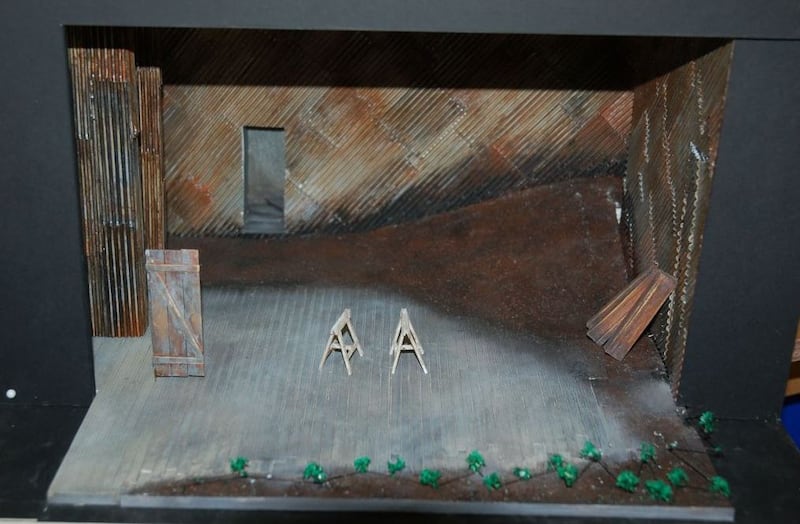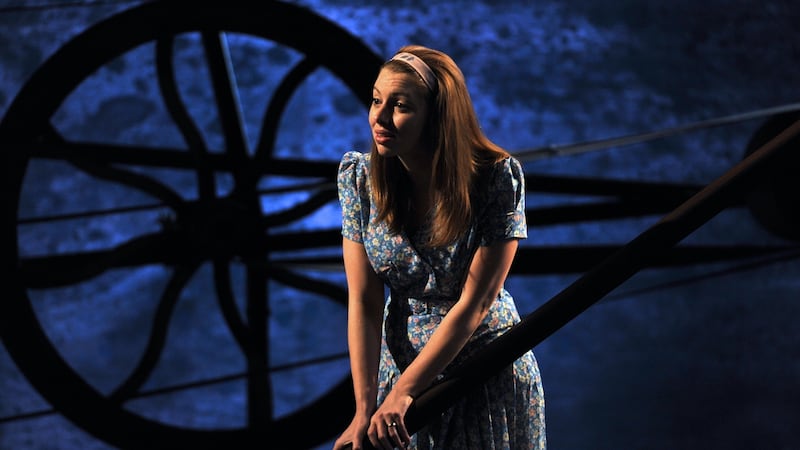Francis O’Connor reaches into a black model box, about the size of a domestic oven, and carefully begins to reposition the tiny furniture. The banister has fallen off a staircase, he apologises, lost somewhere in his workshop at home in Surrey, which he is confident will not happen with the full-scale version.
It is a significant day for his latest stage design for Druid, the Irish company with which he has collaborated most frequently, here on a dark and sly imagining of The King of the Castle, Eugene McCabe's 1964 play of sex and greed in rural Ireland.

O'Connor, a trim and enthusiastic figure, had that morning revealed this fastidiously crafted miniature to director Garry Hynes and her cast and crew in Dublin, an audience of more than 20 people, and was travelling the next day to Galway to see its construction: the transition from an idea to reality.
Model boxes, which always contain the thrill of a dolls' house, are no longer essential tools for a stage designer. Many work exclusively with computer software and walk the company through their ideas with the click of a mouse. O'Connor began collaborating with Hynes in 1997 on the demonic home in Martin McDonagh's The Beauty Queen of Leenane, and has created some of the most striking stage pictures for theatre and opera in Ireland, the UK, and beyond. He remains committed to their physical charms.
“The joy of putting a model together is the joy of design,” he says. “The more I can create in a model, and the technical drawings, the better it will work later on. I need to communicate how I want it to look in three dimension in a space.”
The detail of O’Connor’s model, whose walls climbed high with a clutter of window frames and resolved in a muted, abstract painted backdrop, was both enthralling and slightly concerning. Everything in it was handmade, from the mismatched chairs to a long rectory table of a farmstead home, through which O’Connor was signalling the building’s shifting, ad hoc history. He laughed at any suggestion of obsessionality: this is what designers do.
Visual hooks
For McCabe’s originally scandalous play – in which the ageing farmer Scober MacAdam, hungry for status and bitterly childless, entreats a travelling labourer to impregnate his young wife Tressa – O’Connor had mingled practical and symbolic references. At the rear of the stage hung a bisected threshing machine, all spindly frame and rotating wheels, which curled downwards like a crooked finger – or, perhaps, a different anatomical feature – and which would whirr and grind onstage during the opening scene. The set was a performance in itself.
“My collaborations with Garry have always been to try and find something new to say with a play, but to be truthful to it,” O’Connor says. “So we try and strip things back, I suppose. In this play we were trying to find the essence of what we need in order to articulate the story. There are certain things that present themselves in the script that are visual hooks.”
The thresher is one such hook. One character’s description of the Scober home as an asylum, together with his profligate wealth, suggested windows, spilling light, “like beacons”. But elsewhere the script made such careful description of the material world around the characters, that O’Connor felt he did not need to. “I think that it’s better to expect the audience to fill in gaps. In this play we could pare everything back and deliver something with a vivid neutrality – that’s what I’ve been calling it.”
Vivid neutrality may be a god way of describing O'Connor's work in general: however spectacular, bold or contemporary his stages are, they never get in the way of a performance or call undue attention to themselves – everything is at the service of the play.
The earthy materiality for DruidSynge, DruidMurphy and DruidShakespeare provided rich textures for those worlds, whether against corroded corrugated steel backdrops, or upon soil churned up by war and violent succession, all distinctive and malleable playing spaces for the life of a performance. The hard sheen of his luxuriously black sets for John B Keane helped strip any sentimentality from the plays. His jagged deconstruction for the Abbey's The Aristocrats put Friel in new light. The translucent structures for Druid's The Colleen Bawn made 19th-century melodrama seem freshly experimental. And last year's astonishing Waiting For Godot, which Druid will tour again next year, showed how much more there is to imagine in that famously exacting and sparing work.

What struck O’Connor most forcibly about McCabe’s play was its surprising modernity; its unabashed command of sex and personal politics. One response has been to provide a kind of counterpoint to that physicality: O’Connor intended his set pieces to fly on without conspicuous assistance from stagehands, instead emphasising the chilly distance between characters. “I mean, I love junk,” he admits. “In the right play it’s great. But in this case you need to see things with utter clarity.”
Truthful response
O'Connor's collaborations with Hynes and movement director David Bolger usually begin as far as possible in advance of a production, often with long gestation periods. "It sort of happens in bursts. We'll have both read of it, meet up and share our initial reactions. It usually starts with some enthusiasm – 'Oh, God, it's really good' – or some question: 'Why are we doing this?' "
O’Connor is hesitant to describe designers as interpreters of other people’s work, but he agrees they are often the first responders, providing the parameters in which the director, actors and other collaborators can work, giving clues to the audience, defining the world – all within strict limitations of space and budget. It is an art of accommodation.
He is similarly slow to describe his style: “I’m not a designer who wants one thing after another to look the same. There are certainly a few symbols and things I enjoy. But I don’t want to impose a style. I want it to come from a truthful response to the piece.”
If O'Connor inherently recognises the collaborative nature of theatrical design, it is because that is how he arrived at the profession. In Teeside, in northeast England, he acted in youth groups, later pursuing theatre studies in college. There he discovered a flair for design, which led to his enrolment in the Wimbledon School of Art under the mentorship of the legendary Richard Negri, who designed the innovative theatre space of the Royal Exchange in Manchester. Such were the imaginative inversions of that course, that O'Connor spent much of his years there directing and performing. "It was to teach us more than an aesthetic response, but how to find – this sounds wanky – the innate theatricality in something like in an object."
That concentration is what you retain from O'Connor's vivid stage worlds: a pair of rolled-up gloves, on a bone-white set, that symbolised a lost daughter in the Abbey's Big Maggie; a twisted chandelier that recalled the retreating synapses of a tragically dementing mind in the Gate's The Father; or the tangled lines within Godot's tree, constructed from galvanised, six-inch nails, in a biblical allusion drawn from the text.
The quintessence of stage design, though, is its impermanence. “It’s on, it’s gone,” says O’Connor. “And that’s the glory of it, actually.” Growing efforts to keep archives of the disappearing act of stage design are welcomed, but even model boxes take up significant space.
"They are beautiful things: tangible, tactile connections to a production," he says, as we peer into the coming world of The King of the Castle. "But the things to keep are the memories of it."
He recalls one, a spry moment of unshowy magic, from Druid's 2002 production of Christian O'Reilly's The Good Father, in which its two characters visit a beach and the only thing O'Connor used to summon it was to have the actors Derbhle Crotty and Aidan Kelly empty their shoes of sand. "I get off on those little things," O'Connor says smiling. "Not the big moments. Those are the things that stay with you."
The King of the Castle is at Gaiety Theatre, Dublin as part of the Dublin Theatre Festival until October 15th













